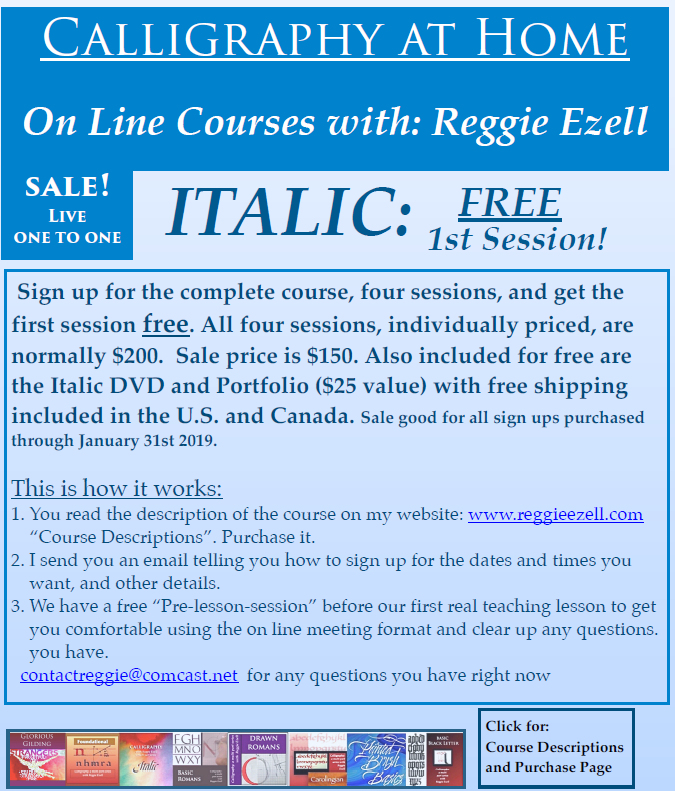
* * * * * * * * * *
Week #53
This work was done by Maria Helena Hoksch in 2017 in New Orleans for the session “ Italic and Variations” in 26 Seeds: a Year to Grow. In her own words:
|
Creating a classic book from start to end
is a monumental task. Perhaps done only once in a lifetime, or so I
think right now, having spent almost 300 hours and not yet entirely
done. It still needs to be bound, and it needs a jacket. The idea started out as a requirement for a certain calligraphic accomplishment I once pursued briefly. All my choices for the book came as part of a generous tutelage and advice of my longtime mentor Sheila Waters. She is a genius in handmade books, kind expert, firm teacher, one of a kind. She watched over every preparatory step, while I was attending her masterclass. Then my life changed, and I abandoned my brief goal. With that, I also abandoned the unfinished book project, while it was still in a mock up, paper trial phase. But I also sadly almost left unused all the knowledge I had already absorbed. Two years later, last year, creating a handmade book was Reggie's homework assignment. I became determined to turn back to my abandoned baby. I pulled out my rough and decided to finish it. After all, I had ordered and paid for the skins. At that point the poems and rough spread of pages were picked with Sheila’s help, but I had no idea how to illustrate it. Or how I should actually cut vellum. Two books that were essential to me in final layout and vellum were Edward Johnston’s “Writing and Illuminating and Lettering” and Heather Child’s “The Calligraphers Handbook”. And the primary classic rules Sheila had conveyed throughout the planning. For me it had to be a classic, traditional book, or no book at all. So I learned all about proper alignment throughout, classic margins, vellum cutting, etc. Yet using poetry made it all more difficult. Not all classic rules apply to writing out poetry, which Edward Johnston calls “fine writing”. You cannot change freely where to break lines, so you cannot follow the rules of margins quite exactly. You have to decide on your own margins according to the longest and shortest lines. Actually it was rather complicated. |
I
used split manuscript quality sheepskin from Pergamena for the book.
I placed the order on the phone with one of the owners, explaining
that all my skins needed to be similar to each other. Yet some came
smaller than others, as nature had made them. Measuring them over
and over actually determined the exact size of my book. I decided I
would fold pages at the spine of the book only along the spine of
the animal. I cut the skin alone at home, saying a prayer first. In
vellum manuscript, the flesh side always faces the flesh, and the
hair side faces the hair side, in the finished book, so you have to
plan that as well. It further complicates the whole process. Even though your page one may be attached to page 12, you still cannot letter one whole spread at a time, skipping pages that will fall in between in final bind. You have to letter according to how text flows. Your hand changes throughout lettering the book slightly, as it is a long task. So the reader should always view two pages lettered very similarly, one after the other, together. Now, I can go on and on about this. It was an endless task. Each moment knowing that you cannot easily redo things when mistakes happen, as your skins were ordered four years ago, and you only have one spare extra spread. You cannot reorder the whole batch as it cost $500.00 And if you redo something, you possibly have to redo four pages, not just one. So much is up to luck and you hope for the best. You cannot expect perfection in every single detail. I know some of you are curious about illustrations and gilding in my book. These were done after all of the lettering was finished. I got into different thinking mode than was needed for writing. I decided to use nudes as I wanted not to bother with period clothing for my figures, which are from Byron times supposedly. I felt that abandoning any garments gave the illustrations, and therefore to the whole book somewhat fresh and also eternal quality, both at the same time. Nudes on vellum are certainly rare creatures, so I put them into mysterious, Eden like atmosphere, with certain Art Deco feel. The illustrations involve watercolors, colored pencils, pointed pen, gilding, and metallic paint. As for the lettering, italic was from the beginning my only, and even the only obvious choice, though it is not my “first and basic” hand. Classically, italic is the best fit for romantic era poetry, in my true belief. The book was lettered in hand ground black Japanese stick ink. The book measures 9”x7” when closed. |

